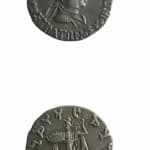Indo-Greek Silver Tetradrachm of King Strato I, 125 BCE - 110 CE
Silver
C.2252
Obverse: Head of the King Wearing a Helmet Reverse: The Goddess Pallas Athena Standing to the Lef Like many of the Indo-Greek kings, little is known about the life and...
Obverse: Head of the King Wearing a Helmet
Reverse: The Goddess Pallas Athena Standing to the Lef
Like many of the Indo-Greek kings, little is known about the life and reign of King Strato I. He is believed to have ascended to the throne at an early age, and his mother Queen Agathokleia presumably acted as regent. His father’s identity, however, remains mysterious. Originally, scholars speculated that Strato was the son of the great King Menander I, placing his reign around 130-110 B.C. However, recent research seems to indicate he ruled later on, approximately 110-85 B.C. To make matters more confusing, there are others who propose, based on numismatic evidence, that Strato I was actually two different kings who ruled separate territories simultaneously. In this scenario, one Strato is the youthful son of Agathokleia and the other Strato may have been her brother. That being said, on his coinage, Strato’s portraits show him aging from youth to middle age. He is the only Indo-Greek king to be depicted with a beard, as if to assert his maturity. As the king ages, Agathokleia’s importance is gradually diminished and her name disappears from the legend on his coinage.
How many hands have touched a coin in your pocket or your purse? What eras and lands have the coin traversed on its journey into our possession? As we reach into our pockets to pull out some change, we rarely hesitate to think of who touched the coin before us, or where the coin will venture to after us. More than money, coins are a symbol of the state that struck them, of a specific time and place, whether contemporary currencies or artifacts of long forgotten empires. This stunning hand-struck coin reveals an expertise of craftsmanship and intricate sculptural detail that is often lacking in contemporary machine-made currencies. The inscription of the obverse of this bilingual coin is in Greek, while the reverse legend is the ancient Indian language Prakrit, written in Kharoshthi script, reading Maharajasa tratasa Stratasa and can be translated as “-of the king, savior, Strato.” This coin is a memorial an ancient king and his empire passed from the hands of civilization to civilization, from generation to generation that still appears as vibrant today as the day it was struck.
Reverse: The Goddess Pallas Athena Standing to the Lef
Like many of the Indo-Greek kings, little is known about the life and reign of King Strato I. He is believed to have ascended to the throne at an early age, and his mother Queen Agathokleia presumably acted as regent. His father’s identity, however, remains mysterious. Originally, scholars speculated that Strato was the son of the great King Menander I, placing his reign around 130-110 B.C. However, recent research seems to indicate he ruled later on, approximately 110-85 B.C. To make matters more confusing, there are others who propose, based on numismatic evidence, that Strato I was actually two different kings who ruled separate territories simultaneously. In this scenario, one Strato is the youthful son of Agathokleia and the other Strato may have been her brother. That being said, on his coinage, Strato’s portraits show him aging from youth to middle age. He is the only Indo-Greek king to be depicted with a beard, as if to assert his maturity. As the king ages, Agathokleia’s importance is gradually diminished and her name disappears from the legend on his coinage.
How many hands have touched a coin in your pocket or your purse? What eras and lands have the coin traversed on its journey into our possession? As we reach into our pockets to pull out some change, we rarely hesitate to think of who touched the coin before us, or where the coin will venture to after us. More than money, coins are a symbol of the state that struck them, of a specific time and place, whether contemporary currencies or artifacts of long forgotten empires. This stunning hand-struck coin reveals an expertise of craftsmanship and intricate sculptural detail that is often lacking in contemporary machine-made currencies. The inscription of the obverse of this bilingual coin is in Greek, while the reverse legend is the ancient Indian language Prakrit, written in Kharoshthi script, reading Maharajasa tratasa Stratasa and can be translated as “-of the king, savior, Strato.” This coin is a memorial an ancient king and his empire passed from the hands of civilization to civilization, from generation to generation that still appears as vibrant today as the day it was struck.



